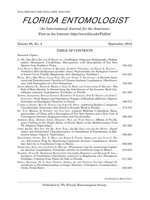Recently, a strain of Isaria fumosorosea Wize (Ifr) (= Paecilomyces fumosoroseus [Luangsa-ard et al. 2005]), (Hypocreales: Cordycipitaceae) was discovered in a Florida citrus grove infecting the Asian citrus psyllid, Diaphorina citri Kuwayama (Meyer et al. 2008). Also, laboratory studies have demonstrated that Ifr may be effective against several commercially important pests of citrus (Poprawski et al. 1999; Avery et al. 2009; Hoy et al. 2010; Hunter et al. 2011). Therefore, the use of Ifr (PFR 97™ 20% WDG, Certis USA, Columbia, Maryland), approved in 2011 by EPA for use in commercial citrus, may offer a potential tool for balancing citrus pest management with consumer demands for organic citrus produce.
The brown citrus aphid (BCA), Toxoptera citricidus Kirkaldy (=T. citricida [Nieto Nafría et al. 2005]), (Hemiptera: Aphididae) was discovered in Florida in 1995 and is recognized as a serious pest of citrus capable of vectoring citrus triseza virus (Halbert & Brown 1996; Michaud 1998; Roy & Brlansky 2009). Under optimal conditions, native natural enemies provide good management of BCA, although these are easily disrupted by insecticide applications (Michaud 1998; 2002). Presently, the aphid's population is managed in part by the parasitoid Lysiphlebus testaceipes Cresson (Hymenoptera: Braconidae) (Evans & Strange 1997). This generalist aphid parasitoid Lysiphlebus testaceipes, native to Florida and the Americas, is an effective biocontrol agent of BCA (Evans & Strange 1997). The objectives of our study were to assess the impact of Ifr on the mortality of BCA populations as well as the parasitism and emergence rates of L. testaceipes.
BCA and Carrizo citrus (a trifoliate hybrid: Washington navel x trifoliate orange) were obtained from the Sub-Tropical Insect Research Unit, USDA Horticulture Research Laboratory in Fort Pierce, Florida. For the experiment, 5 carrizo citrus seedlings (25–30 cm tall) were placed in each of four separate nylon mesh-covered cages (35 × 35 × 35 cm) and each infested with 4 alate BCA (20 per cage). A second infestation was made after 9 days. Cages were maintained in a growth room at 24.0 ± 1 °C, 45.0 ± 1 % RH and 16:8 h (L:D) photoperiod. Two weeks later, 10 L. testaceipes adults were added to two of the cages. After an additional 4 days, one cage with and without L. testaceipes was treated with Isaria fumosorosea (Ifr) suspension (PFR 97™ 20% WDG) at 107 CFU/ml using Nalgene® (Nalge Nunc International, Rochester, NY) aerosol sprayer. The germination of PFR 97™ blastospores was 96% using the technique of Avery et al. 2009. The remaining 2 cages were sprayed with an equal volume of water. Parasitoids were temporarily removed from all cages prior to spraying to eliminate potential drowning and were replaced with an additional 5 to compensate for handling stress. Two replicates of the same study were conducted on different dates.
For the assessments, the number of live aphids on plants, and mummies, were recorded weekly over 6 weeks. Overall, compared with controls, fewer aphids were recorded in L. testaceipes but not Ifr treatments in the final 2 weeks of the study (Table 1). There was no apparent difference in aphid mortality between treatments L. testaceipes only and L. testaceipes plus Ifr. The number of mummies (both unemerged and emerged) was similar between treatments L. testaceipes only and L. testaceipes plus Ifr, suggesting that the parasitoid was not disrupted by the fungal treatment (Table 2).
The augmentation of entomopathogenic fungi with current IPM management strategies for T. citricidus and other insect pests, may offer conventional and organic citrus growers an alternative to chemical insecticides alone. Although Ifr caused some aphid mortality (based on symptoms of mycosis observed in aphids that dropped from the plant), its impact was low based on similar numbers of live aphids remaining on the plant compared with controls and lack of mycosis symptoms observed in aphids that remained on the plants. However, during the first 2 weeks post-application, it appears that as infected aphids fell off the plant, the Ifr inoculum may have been removed with them, potentially slowing down possible epizootics. Data also suggests that L. testaceipes, and Ifr are compatible, since Ifr treatments did not negatively impact parasitism or emergence. Compatibility of Ifr with L. testaceipes may be useful for managing aphid pests in citrus and other crops, especially under conditions that may promote higher rates of pest infection. Results of other studies involving pest-parasitoid-fungus interactions conducted with Ifr or other species of entomopathogenic fungi concur with our findings; that in an IPM program, a parasitoid and a fungus can be compatible when utilized together (Fransen & van Lenteren 1993, 1994; Sterk et al. 1995a, b; Mesquita et al. 1997; Askary & Brodeur 1999; de la Rosa et al. 2000; Mesquita & Lacey 2001; Jaronski et al. 2003; Kim et al. 2005; Avery et al. 2008).
TABLE 1.
RECOVERY OF LIVE TOXOPTERA CITRICIDUS (BCA) ON INDIVIDUAL CARRIZO CITRUS TREATED WITH AND WITHOUT A PARASITOID (LYSIPHLEBUS TESTACEIPES) AND AN ENTOMOPATHOGENIC FUNGUS (ISARIA FUMOSOROSEA) WEEKS POST-APPLICATIONA.

TABLE 2.
NUMBER OF TOXOPTERA CITRICIDUS APHID MUMMIES (EMERGED and UNEMERGED) RECOVERED FROM INDIVIDUAL CARRIZO CITRUS TREATED WITH AND WITHOUT THE ENTOMOPATHOGENIC FUNGUS ISARIA FUMOSOROSEA (IFR) WEEKS POST-APPLICATIONA.

SUMMARY
Treatments with Ifr alone were not effective for managing BCA populations in these cage trials. However, Ifr did not inhibit parasitism or emergence, and L. testaceipes was highly effective at parasitizing the aphids even in the presence of Ifr. The compatibility of Ifr with L. testaceipes demonstrated potential for managing brown citrus aphid pests in citrus.
ACKNOWLEDGMENTS
We thank Christine Lynch, Brandon Paradise, Robin Barnes, Phyllis Rundell, Eliza Duane, Lindsay Brock, Deanna Pick, Maria Gonzalez, Anna Sarah Hill and Gail Amafitano for their help and assistance; Drs. Ronald Cave and William Overholt for the use of their Bug-Dorms®; Dr. Peter Stoffella at UF-IFAS-IRREC in Ft. Pierce, Florida for statistical analysis assistance. This project was funded by The Direct Grower Assistance: Development and Evaluation of Citrus Grower Psyllid Management Programs 2008 awarded by the Florida Citrus Advanced Technology Program (FCATP08: Control of Citrus Greening, Canker and Emerging Diseases of Citrus).





